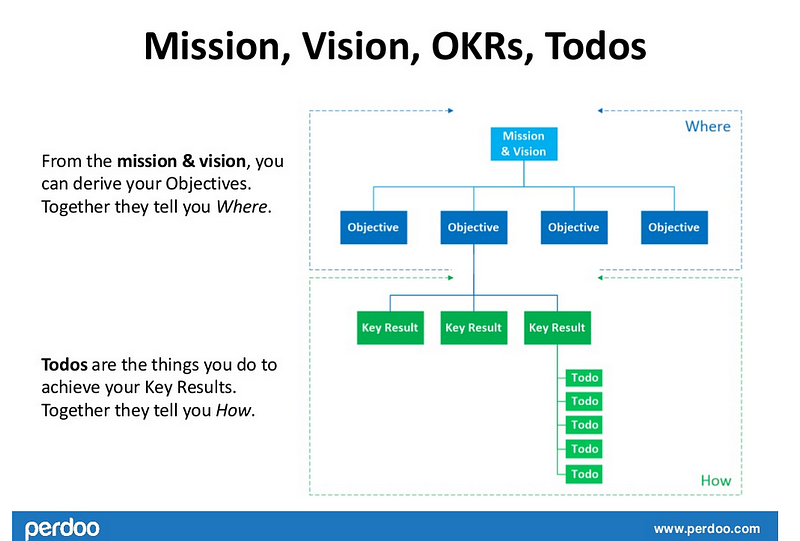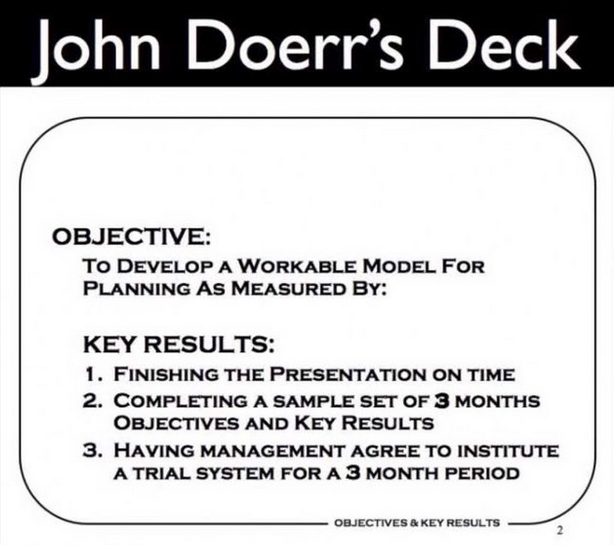Fried OKRA: A Management Framework for People Who Don’t Like Vegetables. — Medium
Fried OKRA
A Management Framework for People Who Don’t Like Vegetables
tl;dr: I took OKRs and made them tastier by linking them to Actions.
In the South, where I’m from, we love to take healthy vegetables and make them tastier by adding some sort of fatty goodness to them. The primary way we do that is coating them in cornmeal and frying them (well, there’s also slow cooked greens but that’s another blog post altogether).
I got to thinking: perhaps this technique is more generally applicable.
I know that management frameworks are good for me and my team, but they’re just not very appetizing. So here’s an experiment in deep fried management.
Fried OKRA
OKRs are the good-for-me piece of this. They stand for Objectives and Key Results, a simple and flexible framework that companies like Intel, Google, and LinkedIn use to keep their teams headed in the same directions and make consistent progress. You can read more about them here, here, and here, but if you haven’t heard of them you might also want read on anyways.
Here’re the major components of the framework in a diagram by Henrik-Jan van der Pol, who I discovered is on to something similar:

For the purposes of this post, replace ‘Todos’ with ‘Actions’. We’re trying these out at my startup, Trinket. So far they’re good for ya and tasty too! Let’s dive into each in turn.
Vision
- How will the world be different because you exist?
- e.g. “Code in Every Classroom”
Vision is a key component of what makes groups distinct. If a vision is murky it is likely that members will have difficulty staying motivated and focused. Vision may evolve or change early on in a group’s development but as it matures, vision should solidify and become well-known to everyone and often repeated by the group’s leaders.
Mission
- What’s the main way you’ll accomplish your vision?
- e.g. “Build the easiest way to make and share code”
The mission is the overall thesis the company or group has about how its vision will be realized. It’s relatively stable but may change every decade or so. If your vision is “the absence of hunger” then you might have a mission of making the world’s best liquid meal replacement like Soylent but one day move on to making space-age bionic stomachs. You get the idea.
Now come the OKRs

Objectives
- High-level, unambiguous milestones
- Together, they achieve or significantly advance your mission
Mission and Vision are favorites of big-picture thinkers, but it’s achieving objectives that will actually get us there. Explicitly stating the key objectives that you think will move you furthest towards your goal is a difficult and important step.
For large organizations, Objectives can ‘nest’ so overall goals are supported by departmental or team goals. For small organizations like startups, they may be a ‘flat’ series of critical path items.
The number and source of Objectives is a key management style decision. Will you determine them collaboratively? With whom? When will they be revised?
Key Results
- Very specific success stories
- Together, a group of KRs achieves an Objective
- Time bound (months or less)
- Measurable (ideally with paired metrics accounting for e.g. quality vs quantity)
- Ambitious (roughly 60–70% chance of success)
Some organizations encourage each person to develop Objectives and Key Results for themselves, and to review them with a manager. How will Key Results be developed in your organization?
A caution from none other than Intel’s Andy Grove himself: make sure that you measure all of the key dynamics around your goals. Sales of computer chips are a function of satisfying demand, measured by production, and repeat business from customers, measured by quality and satisfation. If that’s your Key result, make sure BOTH metrics make it in or you’ll end up “Achieving Faliure” as Eric Ries so poetically puts it. Grove calls this technique paired metrics and it’s widely applicable when two things, usually some pair of quality, speed and cost, vary inversely.
Finally, a note about the Ambitious section. It may seem strange and is likely counterintuitive that Key Results should only be 60–70% complete on average. This is a forcing function to make sure that a team is setting its sights beyond its capacity.
Personally I find goals I’m not going to fully achieve a little demoralizing. But luckily there’s some crunchy fried coating coming up, Actions, that will help me visualize the series of things I’d need to do in a perfect workd to achieve 100% of the key result. If my KR is ambitious, this will be more than I can actually accomplish within the time-frame of the KR. It will still be theoretically possible, though, and making that plan forces me to actually visualize what the KR will look like.
Ok let’s move on to the tasty bits, Actions: actually, finally doing something!

Actions
- A thing you or your team can almost certainly *do*
- Together, they achieve a Key Result
- Time-bound with short periodicity (weeks or less)
- Measured by conversion rate towards specific KR metric where possible (ideally by two paired rates such as sign up rate + cost per signup)
- Each Achievable, but together are > 100% of capacity for the time period, creating scarcity
- Periodic prioritization ranks actions by conversion rate
Actions are where the Objectives and Key Results meet work planning. By measuring the degree to which specific actions contribute to the Key Results metrics, managers should be able to double down on what’s working .
Conversion rates towards KR metrics are best if your activities are amenable to measurement in this way. They will help you know very soon in the process how well you’re doing and your chance of hitting Key Results. This also lets you re-focus efforts on the activities with the biggest impact and diagnose and correct what’s not working earlier on.
If Actions don’t seem to be moving your Key Results metrics, there’s a mismatch that you need to diagnose. Perhaps you’re measuring code velocity without measuring customer bug reports and complaints. For a Key Result like ‘Acheive 9/10 net promoter score,’ fixing bugs may be as crucial a contributor as how many features you shipped during that time.
The other reason why Actions might not be moving your metrics, of course, is that they’re a distraction. This can be a tough realization but if you don’t see any problems with your Objectives and Key Results and you can’t reconcile the mismatch, it’s likely time to cut that activity in favor of others that make a difference.
Finally, some of the people I’ve showed this post to have wondered about the ‘Achievable’ quality of actions. This is on purpose. While Key Results can and should be Ambitious, we have to be realistic in planning. Actions should be a plan of acheiveable bits like ‘send X emails’ or ‘spend 10% of time on bugs’ that we’re confident is theoretically possible. But, to achieve our ambitious Key Results we’ll have to plan for more than 100% of our capacity during a given time period.
The pressure on your time and resources combined with a feedback loop that determines which actions are most efficient is what drives out wasted effort and helps us become ever more ambitious. Linking Actions and Key Results enables this loop.
Building Frameworks Around Humans
When I first wrote and circulated this idea, many of my reviewers said “wait up, you’ve got to take into account human motivations.” They were exactly right.
It’s crucial to make sure that the process of planning does not inhibit the creativity or agency of anyone on your team. The Actions that team members are taking should ideally be suited to their professional goals and personal strengths.

Consider this scenario: a marketing manager loves writing blog posts. In addition to doing all the other parts of her job, she maintains the company blog and enjoys doing so. If her Key Results don’t measure the impact of this work then we’ve hit one of the mismatches above.
As a manager, attempt to re-align your team’s goals with Key Results. If a Key Result is Signups, for instance, make sure that the signups from blog traffic can be measured. This will allow your team member both to demonstrate how her activity is contributing and optimize it towards the key result. Explicitly linking the two may inform the layout of the blog, for instance. Or, the team member may discover that the blog’s mailing list is a key contributor to user re-engagement, yet another Key Result metric. This helps avoid erroneously de-prioritizing Actions due to lack of proper metrics.
The job of aligning any management framework with individual team members’ goals is always a complex one, requiring nuance and thought. Like all great leadership activities, sincerity, communication, and iteration will give you and your team the best chance of successfully integrating the team’s goals with each individual’s.

Not Just OKRA: You Can Fry Anything
My desire to link OKRs to actual actions was heavily influenced by Eric Reis’ Build — Measure — Learn cycle for product development. But in this case it’s more like Act — Measure — Learn. Like Reis’ Lean Startup, this process should help each individual on your team steadily produce more and more value each cycle.
“Vegetables?? But I don’t Like Fried OKRA Either!”
If you think there’s something wrong with this framework, great! Fry up your own batch. My goals were to take the mission-oriented OKR framework and provide a way to link it to the team’s day-to-day plans in a virtuous feedback loop of what activities where achieving what results.
What do you need your framework to do for you? Take the framework as I’ve described it if it sounds plausible. I’d love to hear stories of what works, how you changed it, and how you implemented it with your team. Or gut it and arrange it into what works for your team. Leadership is a lot like cooking: there are a million ways to make something awesome. Just pick one!
Comments? Find me on Twitter or shoot me an email. You can find other stuff I’ve written here.
Thanks to Michael Dearing for encouraging me to publish this post before it was ready. Thanks also to Kathleen Meil, Gustavo Bitdinger, Christina Goswiller, Tina Nguyen and Courtney Hemphill and the other Harrison Metal students for comments, edits, and thoughts on this framework! If you enjoyed this post, I highly recommend the videos and classes available at harrisonmetal.com, without which none of this would’ve happened.
